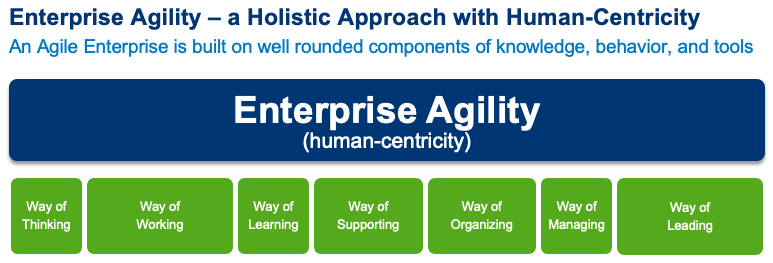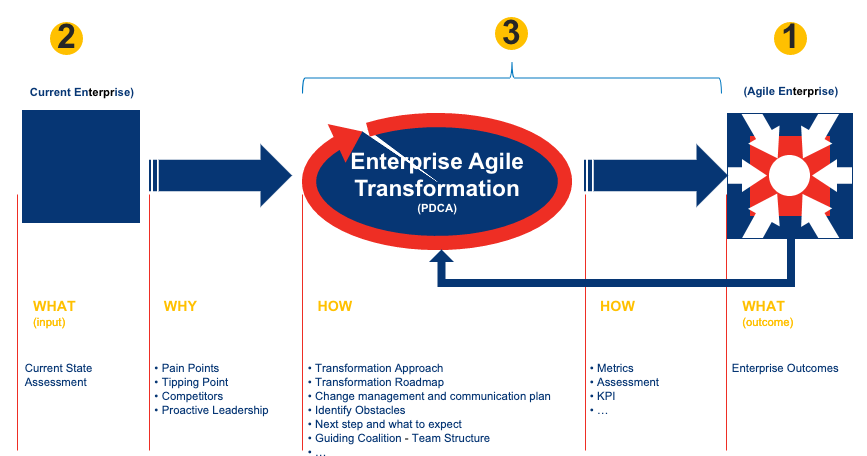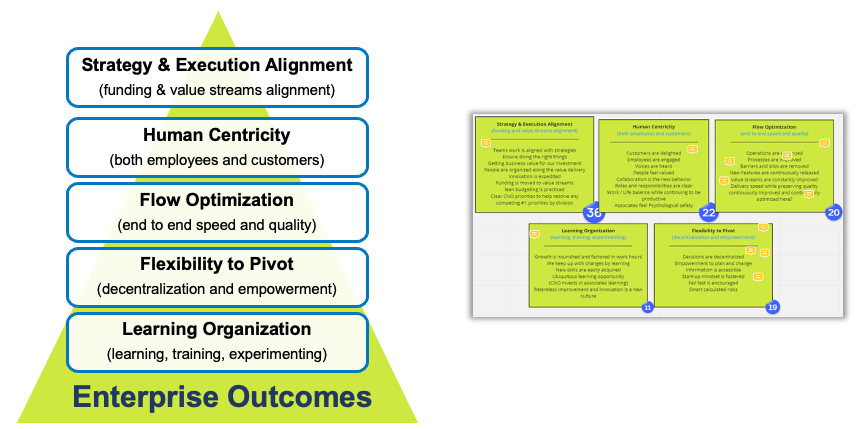 Launching an Enterprise Agile Transformation at a Large Insurance Company
Launching an Enterprise Agile Transformation at a Large Insurance Company
Joseph Barjis, PhD, SPCT Candidate, Adjunct Professor of Agile Systems Engineering, San Jose State University
Note: Note: This article is part of the SAFe Beyond IT series, and it offers real-world Business Agility experiences in Operational Value Streams written and contributed by SAFe professionals.
Abstract
This is a SAFe implementation story at a large insurance company that is evolving from an IT to business initiative.
It was obvious from the outset that the agile transformation will encompass the entire enterprise and therefore I labeled it as “Enterprise Agility”, often referred to as “Enterprise Agile Transformation” with the mindfulness that words shape people’s perceptions, attitude, and expectations. In fact, within months, a merely IT driven Agile transformation started shifting to IT-Business driven, and currently led by a vice president from business. This article narrates the pre-works leading to business embracing and leading agile transformation.
Context
The “Agile practice” started as a merely IT initiative. Even the progress was reported by the percentage of IT projects using agile practice. Non-IT were neither engaged in leading the transformation nor given formal agile training.
When I joined to lead the agile transformation in December 2020 as a “Senior Director of Agile Practice”, the existing stand-alone scrum teams just completed implementing a complex enterprise IT system. The company organized a celebration session on this occasion, attended by teams and executives.
This successful implementation also revealed challenges of alignment across the stand-alone agile teams, setting business priorities, dependencies, capacity-demand management, and closer Business-IT collaboration.
It was decided to scale up the agile practice to address these challenges and seize new opportunities.
With unprecedented executive and leadership support, in February 2021, I kicked off SAFe implementation with a formal inauguration of LACE. At the event, c-suite leaders (Chief Actuarial Officer, SVP and CIO, VP of IT Strategy and Operations Excellence) spoke, other IT and business VPs, and 70-80 employees attended.
The goal at that time was to scale up agile practice from individual stand-alone scrum teams to ARTs so more IT applications can be developed using the SAFe Framework. But, over the course of 12 months, a merely IT agile evolved to and labeled as “Enterprise Agile Transformation” – a success that was seeded in the right language and adequate training.
From the first days, we purposefully planted the seeds of “people”, “business”, “enterprise”, and “enterprise agility” into it as explained in the next section why words matter.
Actions
Below I describe what was conducive to preparing business (enterprise operations, sales, marketing, and product) to embrace and start to lead the agile transformation.
1. Language and Words
My post-doctorate focused on the study of organizational design using the language-action perspective. I knew how to drive actions using words. As Austin [1] puts it, people do things with words.
A month after the LACE inauguration, in March 2021, in a 60-minute session, when I delivered my approach for “Enterprise Agility”, I subtitled it with “human-centricity” (see copy of a slide in Figure 1) to already introduce that all people in the enterprise are participants of this transformation and all areas of their functions are the focus for agile practice. The approach was formulated as new ways:
- Way of Thinking – philosophy, concept, theory…
- Way of Working – frameworks, technical excellence, implementation, application domain…
- Way of Learning – body of knowledge and skills, innovation, relentless improvement…
- Way of Supporting – tools, metrics, data analytics…
- Way of Organizing – organizational design, values streams, system perspective…
- Way of Managing – OCM, communications, repositories…
- Way of Leading – agile leadership, executive engagement, vision, strategy…
For example, “Way of Organizing” emphasizes that an Enterprise is a system and for this system to be agile, all its elements (components) must be collectively agile, whether it is creating a marketing content, designing an insurance product, improving enterprise operations, or coding. Way of Organizing also stresses organizing around value flow, but, most importantly, it emphasizes organizational design and redesign due to fundamental changes that an agile transformation brings about.

The words “enterprise agility” imply that all functional areas can benefit from agility, thus, ought to adapt agile practice for optimum overall outcome. Thus, the language that shapes the perception and reaction of people.
2. Balanced Training
The business leadership and associates (VP, SVP, senior directors, directors, and managers of enterprise operations, sales, product, marketing, HR…) were trained with the same merit as the IT leadership and associates. If the first Leading SAFe course I delivered to SVP/CIO and IT vice presidents, immediately the second Leading SAFe was delivered to SVP, VP, senior director, director, managers from business (enterprise operations, sales, marketing…).
In fact, it was a person from Business that I asked to lead the Agile Training Academy that we established. He was our bridge and eyes into the business side from a training perspective.
Now, it was the business colleague overseeing our comprehensive agile training curriculum and jointly shaping the training strategy. This was gradually building a sense of ownership with the business side, trust in the new ways we introduced, and widening the business participation, although it was a long way to go. Even today, we are just taking the first steps in applying agile to non-tech works (claims, product).
The training of Business leaders was crucial. We trained them on Leading SAFe with an in-house developed PI Simulation, a product that they knew, could relate to, and appreciate.
3. Executive Coaching
Executive coaching of VP level was a strategic part of fostering non-IT agile mindset. I set a bi-weekly series of executive coaching with two VPs, one from claims and one from sales. At the beginning, I focused on essential SAFe and its new operating system – ART. However, eight months into the journey, in October 2021, we started discussing how to evolve SAFe into “Enterprise Agile Transformation”. In these executive series, in October-December, we discussed the idea of forming an enterprise level department to lead enterprise agile transformation using SAFe Framework and Organizational Design as per Dietz and Mulder [2]. In November, I shared with the business leaders a concept of such a department, its scope, and structure.
These later series of coaching targeted the business buy-in and profoundly instilled a sense of ownership into the mind of business leaders, which culminated in first taking SAFe SPC in January-February 2022, then launching eLACE in April-May, which is now led by a VP from business.
4. Theoretical Foundation
Introduction of Enterprise Agility needed sound definitions:
- What is an enterprise? If a system, what are its components and how do they interact?
- How to model enterprise operations (marketing, sales, HR…) to transform them into agile?
I adapted “Enterprise Ontology” by Dietz and Mulder [2] for the study of the enterprise as a system. My argument was that if the whole system needs agility, that is, Enterprise Agility, we must go beyond IT. Through this vision, the “Enterprise Agile Transformation” in this insurance company, as of June 2022, is co-led by a VP from Business.
Recall, when the SAFe implementation was launched in February 2021, it started with IT, led by IT people, and focused on IT work.
To summarize the actions we took, the success of onboarding business was driven not only by a series of training, but partnering and co-creating with them the transformation approach, asking them to lead the transformation initiative, and letting them to define what business outcomes they want to achieve. Most importantly, letting them sense the ownership of enterprise agility and how to lead the changes to get there.
What else fostered embracing agility by non-IT was a transparent conversation that agile is not a recipe backed by IT for business to follow it. And, of course, the power of language and words such as “business agility”, “enterprise agility”, “business outcomes” have its full effect. Of course, knowledge that agile practice is not just coding and testing, but any work that can be delivered incrementally to learn and get feedback.
Tipping Points
While many actions contributed, here are a few initiatives that played a crucial role to move to Enterprise-wide Agility.
1. Guiding Coalition
In January 2022, I invited hand-picked 15 people to take the SAFe SPC course using these criteria:
- diverse functional areas such as enterprise operations, marketing, sales, product
- influential people in their respective functional areas
- passionate and enthusiastic about the new ways
Eight people were from non-IT areas, including VP and Sr Directors, and seven from IT with the mindset that Agile Transformation should be at least co-led by Business, if not led.
Successful completion of this training took the company by surprise in what happened next. A VP, Sr Director, Director, and other associates started discussing formation of a community with their participation, which led to a guiding coalition that today leads the “Enterprise Agile Transformation”.
2. Enterprise Agility
As a professor, I believe in education. A few weeks after the SAFe SPC course, I delivered a two-hour session called “Enterprise Agility”. The session was structured as follows:
- A regular presentation, where I discussed organizational agility, business agility, enterprise, and enterprise transformation
- A case study “pizzeria” to illustrate enterprise operations (non-IT areas) and what agility would mean for those areas
- Introduction of a new structure to lead the enterprise agile transformation, where emphasis was made on the role of non-IT people to co-lead it
- An open discussion
The session was attended by over 60 people, including 7 vice presidents, 3 of whom were from business, and existing ARTs leadership. In this session, using the pizzeria case, I presented my point of view that if an enterprise (company) wants to become agile, such an initiative must be led by the business and by a broad-base guiding coalition, representing different functional areas, not only IT. I supported my views by refereed publications as well as reports by top consulting companies.
At least for me, the turning point in the discussion part was a direct question by a business VP, something like “Now that we spent two hours. What do you want and how can we support and help?”.
After this session, what was called LACE for the previous 16 months, set and led by IT, started evolving into eLACE (enterprise LACE), whose first and only PO became a VP from the business.
3. External Experts
Now that going enterprise wide agile was certain, the mindset was ripening, and the “Enterprise Agile Transformation” phrase started entering the agile lexicon in the company, we needed experts with a track record in Business Agility and expertise to engage non-IT people.
In April 2022, we brought one SPCT and SAFe Fellow, one SPCT candidate, and one experienced coach with SPC. Around the same time, we hired a Lead Agile Coach, a SAFe contributor.
All the above three initiatives set the agile journey into a new sail, which we hope to become a profound agile practice in non-IT areas. We are taking just the first steps.
Enterprise Agile Transformation Model
Inspired by the Toyota Improvement Kata [3], I proposed a simple model, yet powerful, for our Enterprise Agile Transformation (see Figure 2). Its simplicity makes it easier to grasp how a transformation will happen iteratively, while the items in each of the three steps allow the model to grow to more complexity as needed. Models are means of communication for common understanding and simple models are easier to share with a broader audience and non-IT people.

I developed this simple model for shared understanding and depicting the transformational process at the macro level. Each of the three steps engaged both business and IT people to define and execute the activities of the step. These steps are discussed in the following subsections.
1. Future State – Agile Enterprise
First, we defined what enterprise outcomes we want to accomplish with the Agile transformation. This was a ground-up and cross-functional stakeholders’ effort. People from marketing, product, HR, operations, sales, and IT, from team level to vice presidents of business and IT participated. This exercise resulted in identifying 5 enterprise business outcomes, as depicted in Figure 3.

In Figure 3, on the right side is a snapshot of the Miro board that we used for collaboration and voting on the defined business outcomes. For readability, the same outcomes are typed on the left side but ranked top down according to the votes received.
2. Current State
We wanted to develop an in-house assessment (survey) to establish where currently the enterprise stands in relation to the five enterprise business outcomes. Then, define the gap between the current and future states, which will drive the enterprise agile transformation roadmap. However, for two reasons we could not do that. First, it takes time and a series of iterations to validate an in-house developed survey. Second, we still needed to validate the five business outcomes with the executives, which hasn’t happened yet.
Instead, we took the standard SAFe Business Agility Assessment and conducted a Measure & Grow workshop with participation of business and IT people. The analysis of assessment and brainstorming for improvement resulted in the following growths:
- Define Current Portfolios
- Identify and socialize failed experiments with no negative consequences
- Give voice/visibility to those who are trying to experiment and tell the real story
This assessment, although not aligned with the five business outcomes we previously defined, at least it gave us some directions for immediate improvements and building a coalition around it to lead the immediate changes.
3. Transformation
This is the core step in the enterprise agile transformation model as it involves both the process to conduct the transformation and the transformation itself.
Some of the activities include creating a transformation roadmap, defining transformation increments, OCM plan, forming a guiding coalition, defining success criteria and metrics, and executing the change increments. This is an iterative process, where the learning and feedback of each increment informs the next increment of changes (in Figure 2, see the feedback loop from step 1 to step 3).
Takeaways
Enterprises rarely embrace agile in non-IT areas right away. The inspiration for enterprise-wide agility should be planted through components such as language, training, coaching, sense of ownership, etc., until the conditions are ripe for embracing it. In our experience, the condition seemed ripe:
- When IT demonstrated how Agile resulted in speed, predictability, alignment, and more.
- When the business witnessed increasing predictability in delivering IT solutions.
- When business was well trained, coached, and fully engaged in these new ways.
Usually, this takes 2-4 PIs. By then, the agile momentum reaches its early maturity, agile training is widespread, and the initial skepticism is growingly replaced by trust.
Applying agile practice to non-IT implies taking agile to the operations of an enterprise, which is at the macro level captured in operational value streams (OVS). However, OVS is too high a level of abstraction to apply agile practice. One needs a business process level, where roles, responsibilities, authorities, and human interactions can be identified. For example, how a marketing campaign is executed, claims are processed, hiring is executed, etc. This level of enterprise operations knowledge requires ability to model these operations, for example, build business process models. Then, consider how these models can be executed using an agile practice. I would say, “business process model driven agility”.
Instead of teaching the TTC, Alice, Geek Book simulations, develop in-house business cases. We used an example of how a pizzeria operates, where participants could see pure non-IT operations through the lenses of business processes: ordering pizza, baking pizza, delivering pizza, collecting payment.
Enterprise business outcomes must be defined by a well-balanced representation of people that are close to the enterprise operations, customers, sales, and marketing, as well as people that lead these business units and divisions, people that deliver IT solutions, finance, HR, etc. Such an approach reveals why non-IT areas should be as much a target of agile transformation as IT. Let alone that this broad participation instills a sense of ownership into all, and enterprise agile transformation becomes everyone’s business.